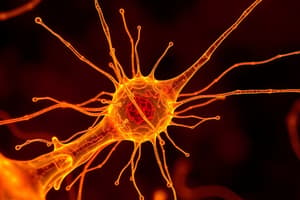Podcast
Questions and Answers
What are the functions of actin binding proteins, such as cofilin and gelsolin, in cell locomotion?
What are the functions of actin binding proteins, such as cofilin and gelsolin, in cell locomotion?
They may create additional free barbed ends for growth or act as capping proteins.
What is the role of cross-linking and bundling proteins in cell locomotion?
What is the role of cross-linking and bundling proteins in cell locomotion?
They form a mesh-like network for support or parallel groupings, as seen in microvilli.
What is the function of membrane-binding proteins in cell locomotion?
What is the function of membrane-binding proteins in cell locomotion?
They provide anchorage for changes in membrane shape.
What is the role of the Arp 2/3 complex in directed motility?
What is the role of the Arp 2/3 complex in directed motility?
What is the role of cofilin in the depolymerization of actin filaments during directed motility?
What is the role of cofilin in the depolymerization of actin filaments during directed motility?
What is the role of vinculin staining at focal adhesions in cell locomotion?
What is the role of vinculin staining at focal adhesions in cell locomotion?
What is the difference in the critical concentration of ATP-actin required for addition to the "barbed" and "pointed" ends of a microfilament?
What is the difference in the critical concentration of ATP-actin required for addition to the "barbed" and "pointed" ends of a microfilament?
What is the role of the Arp 2/3 complex in actin filament formation?
What is the role of the Arp 2/3 complex in actin filament formation?
What is the function of monomer-sequestering proteins, such as thymosins, in regulating actin filament dynamics?
What is the function of monomer-sequestering proteins, such as thymosins, in regulating actin filament dynamics?
What is the role of end-blocking (capping) proteins in regulating actin filament dynamics?
What is the role of end-blocking (capping) proteins in regulating actin filament dynamics?
What is the function of depolymerizing proteins, such as cofilin, in regulating actin filament dynamics?
What is the function of depolymerizing proteins, such as cofilin, in regulating actin filament dynamics?
Where are actin networks typically located in the cell, and what is their role in cellular motility?
Where are actin networks typically located in the cell, and what is their role in cellular motility?



